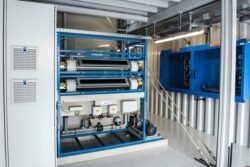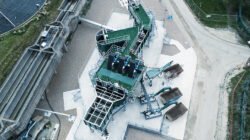Columbus Southerly Wastewater Treatment Plant and Sewers

Situated in the heart of Ohio, the Columbus Southerly Wastewater Treatment Plant (CSWTP) stands as a testament to modern engineering and a commitment to public health and environmental sustainability. Serving a bustling metropolitan area, CSWTP is a key facility within the broader network of wastewater treatment operations that support the greater Columbus region. This article dives into the intricate workings of the plant, its role in serving the local population, handling wastewater volumes, treatment capacities, and features recent advancements and community initiatives.
Overview and Historical Context
The Columbus Southerly Wastewater Treatment Plant was founded in response to the growing urbanization and industrial activities in the 20th century. As Columbus expanded rapidly, it became evident that more sophisticated and efficient sewage treatment facilities were necessary to manage the increasing volumes of wastewater while protecting the environment.
Population Served
Today, CSWTP caters to approximately 1.2 million residents across the Columbus metropolitan area, including parts of Franklin County and nearby communities. The plant is integral to maintaining public health by treating sewage and ensuring that the water released into the environment meets stringent quality standards.
Wastewater Volume and Treatment Capacity
Wastewater Volume
On an average day, the Columbus Southerly Wastewater Treatment Plant processes around 120 million gallons of sewage. However, during periods of heavy rainfall or storm events, the volume can surge significantly, sometimes exceeding 300 million gallons in a single day. This variability necessitates robust infrastructure capable of scaling operations in response to fluctuating demands.
Treatment Capacity
CSWTP has a rated treatment capacity of 330 million gallons per day (MGD), making it one of the largest wastewater treatment plants in the United States. The plant’s infrastructure is designed to accommodate peak flows and ensure continuous and efficient treatment processes even during extreme weather events.
Core Treatment Processes
Preliminary Treatment
Upon arrival, sewage undergoes preliminary treatment where large debris and grit are removed. This phase includes screening and grit removal to protect downstream equipment and enhance operational efficiency.
Primary Treatment
In primary treatment, the wastewater flows into sedimentation tanks where heavier solids settle at the bottom and are removed as sludge. The clarified water then proceeds to secondary treatment.
Secondary Treatment
Secondary treatment involves biological processes where microorganisms break down organic matter. The Columbus Southerly Wastewater Treatment Plant employs activated sludge processes, which are renowned for their effectiveness in reducing biodegradable pollutants.
Tertiary Treatment
In the tertiary phase, further purification takes place through advanced filtration, disinfection, and sometimes nutrient removal, depending on environmental regulations and the specific needs of the receiving water body.
Recent Local News and Developments
Expansion and Upgrades
In recent years, the Columbus Southerly Wastewater Treatment Plant has been the focus of significant investments aimed at expanding capacity and incorporating cutting-edge technologies. One notable project is the installation of enhanced nutrient removal systems to combat issues like eutrophication in local water bodies. These upgrades are part of a $250 million initiative to modernize facilities and meet future demands.
Regulatory Compliance
CSWTP has also been in the spotlight for its adherence to new environmental regulations. The plant recently achieved compliance with Ohio EPA’s updated standards for nutrient discharge, underscoring its commitment to environmental stewardship. This achievement was celebrated in local news as a milestone in Columbus’s journey towards sustainable wastewater management.
Community Health and Safety
In light of the COVID-19 pandemic, the plant implemented additional safety protocols to protect its workforce while ensuring uninterrupted service. The measures received widespread community support and highlighted the essential role of wastewater treatment in public health.
Key Projects and Future Plans
Enhanced Nutrient Removal
One of the innovative projects currently underway at CSWTP is the Enhanced Nutrient Removal (ENR) project. This initiative aims to reduce nitrogen and phosphorus levels in the treated effluent, addressing concerns about nutrient pollution. The ENR project involves the integration of new biological and chemical processes designed to capture and remove these nutrients effectively.
Renewable Energy Initiatives
CSWTP is also exploring renewable energy opportunities to make operations more sustainable. This includes the potential installation of solar panels and the utilization of biogas generated from sludge digestion to power plant operations. These initiatives are not only cost-effective but also reduce the carbon footprint of the facility.
Advanced Monitoring and Automation
Embracing the era of smart technologies, the plant is investing in advanced monitoring systems and automation. These upgrades aim to enhance efficiency, reduce operational costs, and provide real-time data for better decision-making processes.
Community Engagement and Education
Community engagement is a cornerstone of CSWTP’s operational philosophy. The plant recognizes the importance of public awareness and involvement in fostering a collective commitment to environmental protection.
Public Tours and Educational Programs
CSWTP offers regular tours to schools, community groups, and other interested parties. These tours provide insights into the complex processes involved in wastewater treatment and highlight the importance of such facilities in maintaining public health and environmental quality. Educational programs are tailored to different age groups and knowledge levels, ensuring everyone from school children to university students and industry professionals can benefit.
Outreach Initiatives
The plant’s outreach initiatives include partnerships with local environmental organizations and participation in community events. For instance, CSWTP is actively involved in the annual Scioto River Cleanup, demonstrating its role beyond just treatment—it is also a champion for local waterway health.
Customer Advisory Committees
CSWTP has established customer advisory committees that include residents, local business representatives, and environmental advocates. These committees provide a platform for stakeholders to voice opinions, ask questions, and stay informed about upcoming projects and policy changes.
Online Resources
Recognizing the digital age’s power, the Columbus Southerly Wastewater Treatment Plant maintains comprehensive online resources. The facility’s website offers educational materials, real-time monitoring data, and updates on ongoing projects. This transparency fosters trust and keeps the community informed.
A Testament to Sustainability and Innovation
The Columbus Southerly Wastewater Treatment Plant is more than just a facility for treating sewage; it is a critical infrastructure piece that supports public health, environmental sustainability, and economic growth in the Columbus region. Through its innovative projects, regulatory compliance, community engagement, and future-forward vision, CSWTP exemplifies the principles of modern wastewater management. It serves as a model for other municipalities facing similar challenges and underscores the essential nature of investing in resilient and sustainable infrastructure.
As Columbus continues to grow, the Columbus Southerly Wastewater Treatment Plant will undoubtedly remain a cornerstone of the city’s commitment to safeguarding the health of its residents and the environment for generations to come.


